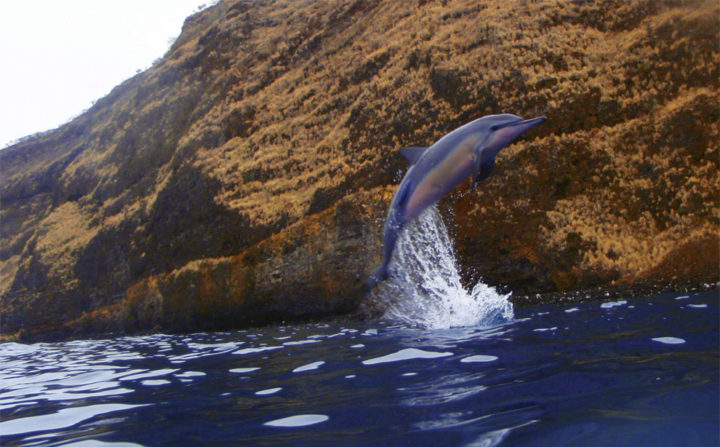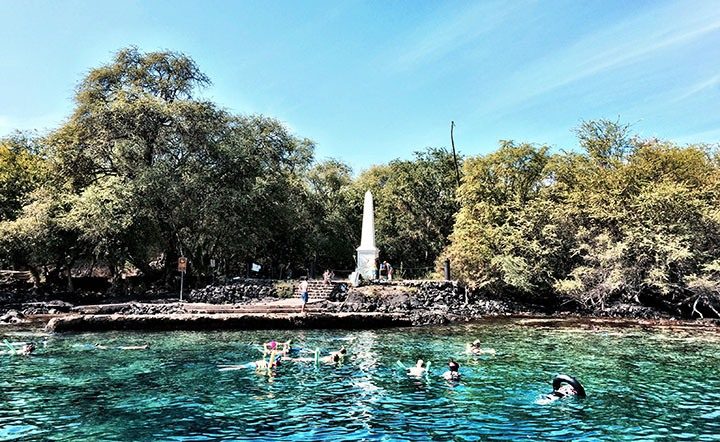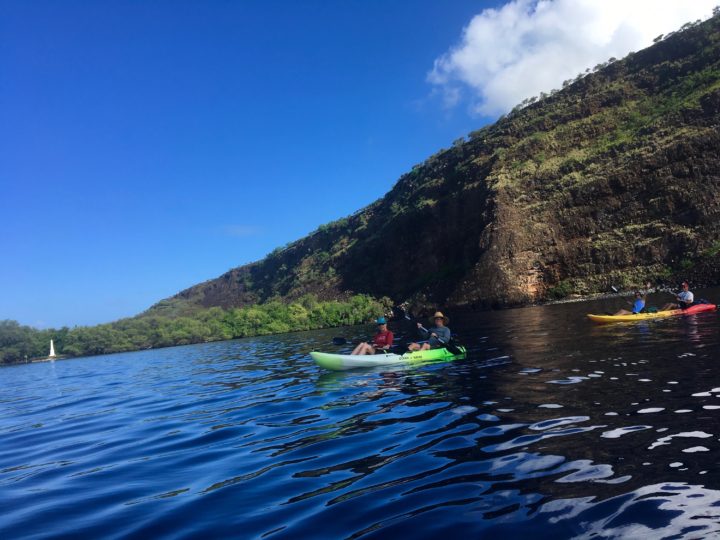Kealakekua Bay at a glance.
Largest sheltered natural bay on Big Island
Ranges in depth from 5ft to over 300 ft
The reef drop inspired Pixar’s movie Finding Nemo
1 mile wide, it is approximately a 45 minute paddle across the bay
Only guided-tours are able to land vessels on the monument side
Boats must be permitted to be in the Bay
Listed as one of the top 3 snorkeling spots on the Big Island, Kealakekua Bay is a marine-life conservation district located roughly 12 miles south of Kailua-Kona. It boasts an active coral reef, home to over 252 different species of tropical fish and acts as a resting area for Hawaiian spinner dolphins.
Hawaiian Spinner Dolphins (Nai’a)

Hawaiian spinners break into smaller groups to hunt at night and regroup in the morning to safely sleep in sandy bottom bays. While “sleeping” they turn off their sonar detectors and rely heavily on sight to sense predators approaching from a distance. Nai’a range in size from 5.5 ft to 7 ft long and the males are typically larger. Their diet is compromised of deep-ocean fish species such as later fish and squid. While playful by nature, remember to keep a safe distance of at least 100ft.
Brief History
Once a favorited spot by Hawaiian royalty, the bay received its name from the Hawaiian phrase “pathways to the gods.” The Hawaiians believed that a person’s mana, power, was stored in the bones. In sacred tradition they would burn the bodies and elect individuals to hide the deceased bones on the cliff edge. The cliff face in Kealakekua Bay, Pali Kapu O Keoua, was named after the father of Kamehameha the Great, who’s bones are hidden in the lava tubes.
Captain Cook Monument

A monument was erect on the northern end of the bay to remember the first extensive contact between Hawaiians and Westerns. Captain Cook and his men arrived in 1779 during a time of celebration dedicated to Lono, the god of fertility. The British men were revered as gods and used this to their full advantage to exploit the local people. When Cook accused one of the Hawaiians of stealing his boat, he went ashore to capture the chief. This resulted in conflict between the two parties and ultimately led to the death of Captain Cook on February 14th, 1779.
Navigating the Bay

Our most preferred mode of transportation is kayak or standup paddle board. Touring the bay in a non-motorized water-craft enables you to soak in the beauty of the drastic cliff faces while getting a front row seat to the changing depths of the deep water bay. As mentioned earlier, dolphins are often experienced early mornings. While the law requires 100ft distance from the animals, they are extremely social creatures and will often come over to check out the kayaks.
Kealakekua Bay is the most sheltered deep water bay on the island. This makes for an accessible enjoyable paddle. The water simulates more a lake water calmness than open ocean kayaking. So for those of you with little kayak experience or young children, this is an accessible paddle.
The Captain Cook trail is not for the faint of heart. The trailhead begins at the top of Napo’po’po road and winds down the mountain 1.9 miles with a 1300 ft elevation change. This is a great option for those that enjoy hiking. Be sure to bring your snorkel gear because you don’t want to miss the underwater views at the bottom.
Wrapping up
Kealakekua Bay is a must-do adventure on the big island. It hosts hundreds of fishes species and is one of the Hawaii’s most extensive coral-reef systems. We would be happy to provide you will all the necessary tools for a successful day in paradise. Stop by the shop or check out our rental page to learn more.
